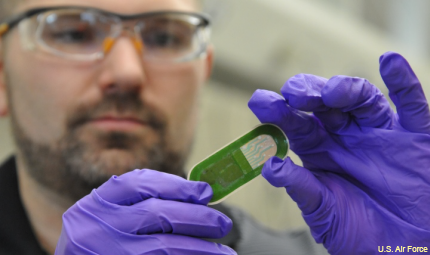AFRL's sweat-sensor app breaks new ground in bio-monitoring
The lab, working with the University of Cincinnati, develops a patch that can deliver key medical information in near-real time to a smartphone.

AFRL’s Joshua Hagen with a sweat sensor prototype.
Smartphone apps that monitor health and fitness are increasingly popular, from devices used to monitor specific diseases, like diabetes, to those that keep track of weight or exercise. The Air Force Research Lab is on the verge of going one better, with a system that tracks many of the same biomarkers as a blood test, but does it by monitoring sweat.
Yes, sweat. The system uses a sensor that looks like a Band-Aid, which collects a sample of a person’s perspiration and relays that information wirelessly to a smart phone. AFRL, working with the University of Cincinnati’s Novel Devices Laboratory, started on the project five years ago and recently completed the first successful test of its prototype at Wright-Patterson Air Force Base, according to an AFRL release.
Researchers say the app could have a significant impact for all of the military services, since it provides a way to monitor hydration, heat stress and other factors that can affect the health and performance of service personnel. Perhaps just as important, the system can be produced fairly inexpensively.
“There are many things you can hand-build in the lab and get to work, but if you can’t make it on a large scale, or if it’s going to be incredibly expensive, then it isn’t feasible,” said Dr. Joshua Hagen, who leads AFRL’s 711th Human Performance Wing, Signature Tracking for Optimized Nutrition and Training (STRONG) team.
Using sweat as a diagnostic tool has been around for decades. Writing in IEEE Spectrum magazine, Hagen’s research partner at the University of Cincinnati, Jason Heikenfeld, notes that doctors use sweat to screen newborns for cystic fibrosis and that researchers have in the past used sweat to measure drug levels in the body. But the process was slow and cumbersome. Just giving a blood test was easier.
The patch-and-smartphone system, however, can deliver a host of medical information in near-real time, Heikenfeld writes.
The research project began by looking for a relatively easy way to monitor airmen’s response to factors such as disease, medication, injury, stress, and other physical changes during training and missions. The team settled first on fatigue, developing indicators of overexertion or dehydration. The patch contains microfluidics that soak up sweat through a membrane that measures specific ions of elements such as sodium, chlorine, and potassium—also known as electrolytes. The teams wanted to see how electrolytes in sweat correlate to those in the blood, since an imbalance in the blood can cause symptoms such as cramping, Heikenfeld said.
The team currently is working on developing more biomarkers to measure other aspects of stress, fatigue and exhaustion. As the prototypes come to fruition, the Air Force will be looking to get them into production quickly. AFRL two years ago sponsored the launch of the Nano-Bio-Manufacturing Consortium to accelerate the commercialization of sweat sensors. The consortium has born under a $5.5 million shared-cost agreement with the Flex Tech Alliance, whose 20 members include Lockheed Martin, General Electric and DuPont Teijin Film, the University of Cincinnati and the University of Massachusetts at Amherst. AFRL put up $2.2million, with the coalition partners accounting for the rest.